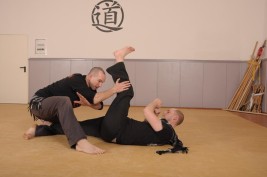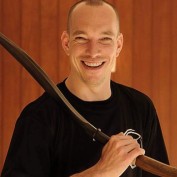I’m a lucky man. Because I took the easy way out. In search of the origins of my Kempo I first went to my teacher Witalli Reingard and trained with him and questioned him. And with Nikolas Sandrock I found the next teacher who has a deep understanding of Kempo. I am also allowed to train with him. And because of my chronic curiosity I have of course asked him a lot of questions. With which ones, I reveal here:
Profile
Name: Nikolas Sandrock
Style: Silat Suffian Bela Diri
DAN Kempo, but Niki DAN grades don’t really matter
lives in: Detmold
trained: among others in the Detmold Faustwerkstatt, at seminars, in the private dojo
When and how did your career as a martial artist begin?
At the age of 6, 1983 Judo at Budo SV Kalletal.
What were your trainers, what influences have shaped you?
There have been a lot of trainers in 32 years, but my masters are Marc Richards from Dragon Fist Kempo and Maul Mornie, Silat Suffian Bela Diri.
I got to know Marc around 1990, until then I had studied Judo, Shotokan and Hadaka Kempo. He showed me Kempo, which is hard and effective, and also introduced me to the other sides of the martial arts (KK). I was allowed to visit him and participate in his life and learn how he integrated KK into his everyday life. He taught me how to train and to experience and exceed my physical limits. In hour-long conversations he explained the values of the martial arts to me and taught me to reflect, analyze, and to refine and optimize my body and mind. For years I spent almost every day with and at his place – training, competitions, courses, training. From the age of 16 I was allowed to support him in teaching, which was probably the most formative phase of my life.
 Training under Maul is something completely different. Marc’s teaching was based on movement, days of training. Maul teaches principles. He passes on knowledge in a compressed form. A weekend with Maul is like a year of training in a club. Maul has massively expanded my understanding of technique and tactics. His humour and relaxed way of teaching has also changed my own way of teaching.
Training under Maul is something completely different. Marc’s teaching was based on movement, days of training. Maul teaches principles. He passes on knowledge in a compressed form. A weekend with Maul is like a year of training in a club. Maul has massively expanded my understanding of technique and tactics. His humour and relaxed way of teaching has also changed my own way of teaching.
In the different phases of my life I have dealt with the different sides of KK, with SV, technique and tactics, with movement and presentation, with spirituality and philosophy, with energy and health. For each of these aspects I have had and still have teachers, each of them has shaped me and my KK and I am incredibly grateful to each of them.
How did you develop your Kempo after you left Marc’s group? What did you change, what did you add? And what is “missing” or was missing from Kempo, what do you miss?
At that time I took a lot of time to take everything I learned apart and understand it. At first I wanted to know more about the spiritual symbolism hidden in Kempo and how it works. For this purpose, I studied old Buddhist, Hindu and Taoist teachings and techniques and dealt with Yoga, Taiji, Hsing Yi, Kyusho Jitsu and Bagua. In Kempo many things are laid out, but nothing is really executed. That is not necessarily bad. It’s like a forest full of gifts, and everyone finds only those that are meant for him and unpacks them – or not.
Later I tried to break down the technical side of Kempo. The main problem is the abundance of movements. Self-defence has to be simple so that it works under stress. So I started to search for principles in our forms and techniques, i.e. few, simple movement patterns that can be applied to many different attacks. I found them and soon discovered that other styles already work with similar principles. So I started to study Philippine Martial Arts (FMA).
To your question: I didn’t add anything, but extracted the principles that were already there anyway and developed methods of practice and made sure that the symbolism of the style in the meditative exercises was given an order, so that it would be easier for the students to find them when they were ready.
Are there successors in your style?
Everyone is the successor, and it is not my style. It is the Lung Chuan Fa, Dragon Fist Kempo. Marc collected and sorted the knowledge, I learned from him and passed it on to the best of my knowledge. Every teacher understands the martial art differently and changes the teaching methods according to his understanding. This is not a new style. You can also say it the other way round: Everybody creates his style, based on his physical and mental potential. If we both train the same style for 15 years, something different will come out in the end. Even more so if we have trained different styles. The moment we move intuitively, what you see then is your own martial art. That’s why I don’t think so much of styles and tradition lines – everybody steals from everybody, and that’s perfectly fine, it’s called development.
 How did you come to Silat? The Silat community seems to be closely linked and structured slightly differently than “normal” martial arts.
How did you come to Silat? The Silat community seems to be closely linked and structured slightly differently than “normal” martial arts.
Via youtube. I discovered Maul’s videos in 2008 and watched them every day and annoyed all my friends with them. The parallels to Kempo are obvious, the work with the principles even clearer than in FMA. In summer 2009 I went to Wiesbaden with my training partner to take part in a seminar. Besides the incredible skills Maul has as a martial artist, we especially liked the friendly, non-competitive way of working in the community. No politics, no belts, no hierarchy – just martial arts. So we stayed.
What are your next goals?
My personal goals in martial arts (hm) … First of all, there is so much accumulated knowledge for me to train. I am looking forward to dive deeper and deeper with my small group and to optimize our skills. Just train! Should there be more for a martial artist?
My goal for the fist workshop is still seminar work. We want to further establish ourselves in the field of self-defence/self-assertion and the training of SV instructors. For this purpose we are working with different schools, institutions and organisations in different areas, and so far with resounding success.
You were or are a real professional, have lived as a “professional” from your martial arts. How do you combine work and family with your rather time-consuming passion for martial arts?
I have two jobs: One is the fist workshop, the other is the carpentry. As long as my three daughters are still small, I want to spend as much time as possible with them. This has not been possible with the regular course operation of the fist workshop (daily 15-22 o’clock). Hence the withdrawal of the fist workshop into the seminar area. I have my Dojo in my own house now, so the children can be present at the training if necessary. My family knows my passion and knows that I have 24 hours of martial arts in my head. Luckily, they regularly give me time for training and further education and have a lot of patience when dad is not available because he is dreaming of techniques …









